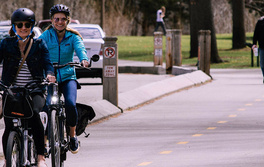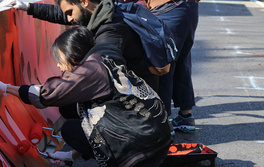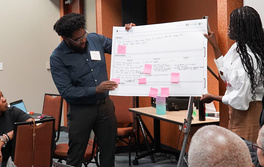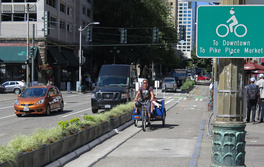
RELEASE: Passenger Distancing Not Sole Factor in Preventing Spread of COVID-19 on Public Transportation, Research Finds
RELEASE: Passenger Distancing Not Sole Factor in Preventing Spread of COVID-19 on Public Transportation, Finds Group of Epidemiologists, Data Scientists & Transportation Planners
User Behavior, Vehicle Ventilation & Trip Duration Among Key Factors to Allow for Increased Occupancy of Transit Vehicles While Reducing Risk of Transmission
Washington, D.C. (August 19, 2020) — Distancing between passengers is not the sole factor determining risk of COVID-19 transmission on public transportation, finds new research published by the Collaborative Group for Modeling COVID and Mobility in Colombia. The research lays out five distinct factors that, when combined, substantially reduce the risk of transmission while also allowing for increased occupancy of public transportation vehicles.
The Collaborative Group for Modeling COVID and Mobility in Colombia is a multidisciplinary modeling team of epidemiologists, data scientists and transportation planners from Imperial College London, Universidad de los Andes, Universidad Nacional de Colombia, Gobernación de Antioquia, NUMO (the New Urban Mobility alliance) and others. The group sought to identify key factors that can determine a safe return to higher occupancies in public transportation operations while preventing transmission of the new coronavirus. The factors are:
- User behavior related to masks, eye protection and traveling in silence to reduce airborne transmission
- Type of vehicle ventilation system and frequency of air renewal
- Proximity of riders
- Trip duration
- Cleaning and disinfecting of high-contact surfaces
These factors were based on a review of studies regarding mass transportation systems in Japan, France, Austria, China (Ningbo and Hunan), Germany and Singapore; research on types of public transportation vehicles in Colombia; reviews in meta-studies and academic commentary; and other research. Additionally, members of the group were able to produce modeling of airborne transmission and tested these models in vehicles. Once factors were identified, the group developed concrete recommendations for mitigating risk of transmission for the use of municipal transit agencies in adapting their own guidelines and mandates regarding safe operating conditions.
Apart from user behavior, one of the key variables is vehicle ventilation, which can take the form of natural (windows or rooftop hatches) or HVAC systems. Proper ventilation has been found to reduce the probability of contagion when air renewal occurs at least once every three minutes and, when combined with other factors such as adequate facial protection and short trip durations (ideally less than 15 minutes), can help lessen transmission risk substantially while also permitting decreased distance between riders.
“It’s the combination of these actions that mitigates the risk,” said research group member and NUMO pilots lead Carlos Pardo. “We’ve found that distancing between passengers can be greatly lowered if everyone uses a high-quality mask and travels in silence, the latter of which is normal in transit. It is also interesting to see how in many cases transit vehicle ventilation is safer than that of residential and commercial buildings, which tend to have relatively lower rates of air renewal."
Currently, public transportation agencies are adjusting their public safety guidelines, occupancy restrictions and operations in response to the COVID-19 pandemic, which has resulted in significant ridership and financial losses. Many agencies — particularly in the United States, where public transit ridership fell 40.8% in March 2020, according to the American Public Transportation Association — have responded by curtailing service frequency and cutting routes. These shifts disproportionately affect millions of people, including, according to a report from TransitCenter, 2.8 million U.S. transit users classified as essential workers and 4.6 million workers earning less than $75,000 annually who rely on transit, based on data from the 2017 U.S. Household Travel Survey.
“Transit is a crucial part of livelihoods as well as a central component of vibrant, affordable, efficient cities. Unfortunately, lack of high-quality, frequent transit is a significant barrier to accessing jobs and the economy, especially for historically underserved populations,” said NUMO director Harriet Tregoning. “These factors and recommendations are intended to help public agencies as they begin to plan for increased service that focuses on providing access to daily needs while promoting public health and safety."
“Factors that Reduce the Risk of Contagion in Public Transport” (published in Spanish) is available here. Please direct media inquiries to Madlyn McAuliffe at madlyn@numo.global.
About NUMO
NUMO is a global alliance that channels tech-based disruptions in urban transport to create joyful cities where sustainable and just mobility is the new normal. Founded in 2019 as an outgrowth of the Shared Mobility Principles for Livable Cities, NUMO convenes diverse allies and leverages the momentum of significant revolutions in mobility to target urban issues — including equity, sustainability, accessibility and labor — impacted by the shifting transportation landscape. NUMO is hosted by WRI Ross Center for Sustainable Cities. For more information, visit www.numo.global
Header image: Marc A. Hermann / MTA New York City Transit / Flickr




